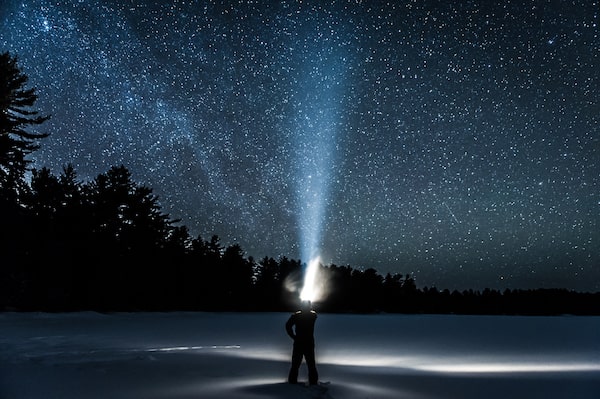
The twilight views in Algonquin Park, Ont., light up even brighter during cool temperatures.Ontario Parks
A 2 a.m. bathroom break drew Kate Ming-Sun from the comfort of a heated tent in Ontario’s Algonquin Provincial Park, when she was met with an unfamiliar sight. “Billions of stars twinkled over me. I’d never seen the sky like that. You can’t see the sky like that in summer because the [tree] canopy would be thick. The stars don’t twinkle like they do when it’s that cold. It was breathtaking,” says Ming-Sun, an instructor at Pembroke, Ontario’s Algonquin College.
A GROWING COOLING TREND
While there are no statistics on winter camping in Canada, anecdotal evidence indicates the pastime is growing. Marian Sonntag, a bookkeeper from Brampton, Ont., has been winter camping at Algonquin Provincial Park’s Mew Lake campground since 1995. “In the beginning, there were maybe 10 campsites taken. Now you can’t even get a reservation sometimes,” she says.
In Ontario’s provincial parks, comforts such as flush toilets, shower facilities, and rental accommodations like heated yurts and cabins are luring campers to Arrowhead, Killarney and Pinery during winter cold spells.
Interest has been stoked in part by social media, says Matt Peters, owner and operator of Winnipeg-based Wilderland Adventure Company, which operates cold weather treks into Manitoba’s boreal backcountry. “Winter camping is part of a growing outdoor movement that includes skills like bush craft, which are popular on YouTube and Instagram,” he says. The practice of living in the bush with little or no tools also honours old school traditions. “One of the first Canadian experiences was simply surviving winter,” Peters says. “And many people want to be challenged.”

Matt Peters is the owner and operator of Wilderland Adventure Company in Winnipeg. With survival and bush craft skills in tow, he brings adventure-seekers to Manitoba’s boreal forests during winter’s chill.Derek Penner
An attractive option for youth, team-building and leadership programs, many getaways can be found close to urban centres making these exhilarating experiences more accessible than ever. Sandilands Provincial Forest, where Wilderlands runs two- and three-day camping trips, is only a 90-minute drive from Winnipeg.
BOUNDARY PUSHING EXPERIENCES
Caroline Barker, a former wilderness guide who now works in mobile banking, is no stranger to getting outside during a cold snap. The Squamish, B.C., resident tackled quinzee building, which involves constructing a fort by piling snow into a heap, carving it out and then allowing it to set. “That was actually really warm. If it’s -10 C or -20 C outside, it can get to -5 C or even 0 C inside a quinzee,” she says.
Over five seasons of winter camping, Barker has also bivouacked (a.k.a. bivvied). It requires stomping a hole in the snow and wrapping yourself in a tarp and sleeping bag which she says is ideal for travelling light during a ski or mountaineering tour. “If you have the right conditions, it can be the best sleep ever. It’s pretty wonderful to lay outside and look up at the stars,” she says.
Barker adds equipment is key. “I have camped in -40 C in a sleeping bag that was only rated to -20 C, and that was horrible. But if you’ve got the right gear, you don’t have to be afraid of the cold. You can just get out there and enjoy winter.”
GETTING STARTED
New campers should put safety first. The gold standard is booking a trip with a reputable wilderness adventure tour operator such as Vancouver-based Canada West Mountain School. With top-of-the-line equipment and the company of an experienced guide with in-depth knowledge of local trails, campcraft, wildlife and history, you can watch and learn from set-up to clean up.
If you choose to go without a professional guide, Peters says always buddy up with someone who has the experience and gear tailored to your destination. Temperatures and conditions vary across Canada and depending on terrain, a trek will require different skills and equipment.

Experience and the right gear – such as this heated tent with a wood stove – are key to thriving in cold and snowy weather.Matt Peters
In B.C., camping gear such as a -20 C sleeping bag, four-season tent and compact stove are carried up the mountains in backpacks. In Manitoba, many winter campers set up heavy and traditional hot tents which are equipped with wood-burning stoves to shelter against -40 C temperatures.
Provincial and national parks offer entry-level experiences with designated campsites that provide warm-up shelters and proximity to other campers, Sonntag says. The social aspect has been a strong draw for her family. “We see the same families over Christmas and March Break in Algonquin. Over the years, our kids developed friendships with kids they only saw in the winter. My 18-year-old is now dating one of those kids she met 10 years ago,” says the mother of four children who are now aged between 13 and 21.
With time and experience, some campers choose to seek the joy of winter solitude instead. “In an area as busy as southern Ontario, it’s very difficult to get a quiet outdoor experience. But folks don’t tend to head out overnight during this season, so large areas of Ontario are yours if you are prepared,” Toronto elementary teacher Jim Graham says.
His family’s camping experiences include sleeping in a quinzee, building a shelter from deadfall trees and bivvying under the stars. They also went camping in the remote highlands of Landmannalaugar, Iceland with no regrets. “We didn’t see anyone for days, hiked, got blown around by 100 kilometre winds and loved every minute of it,” he says.